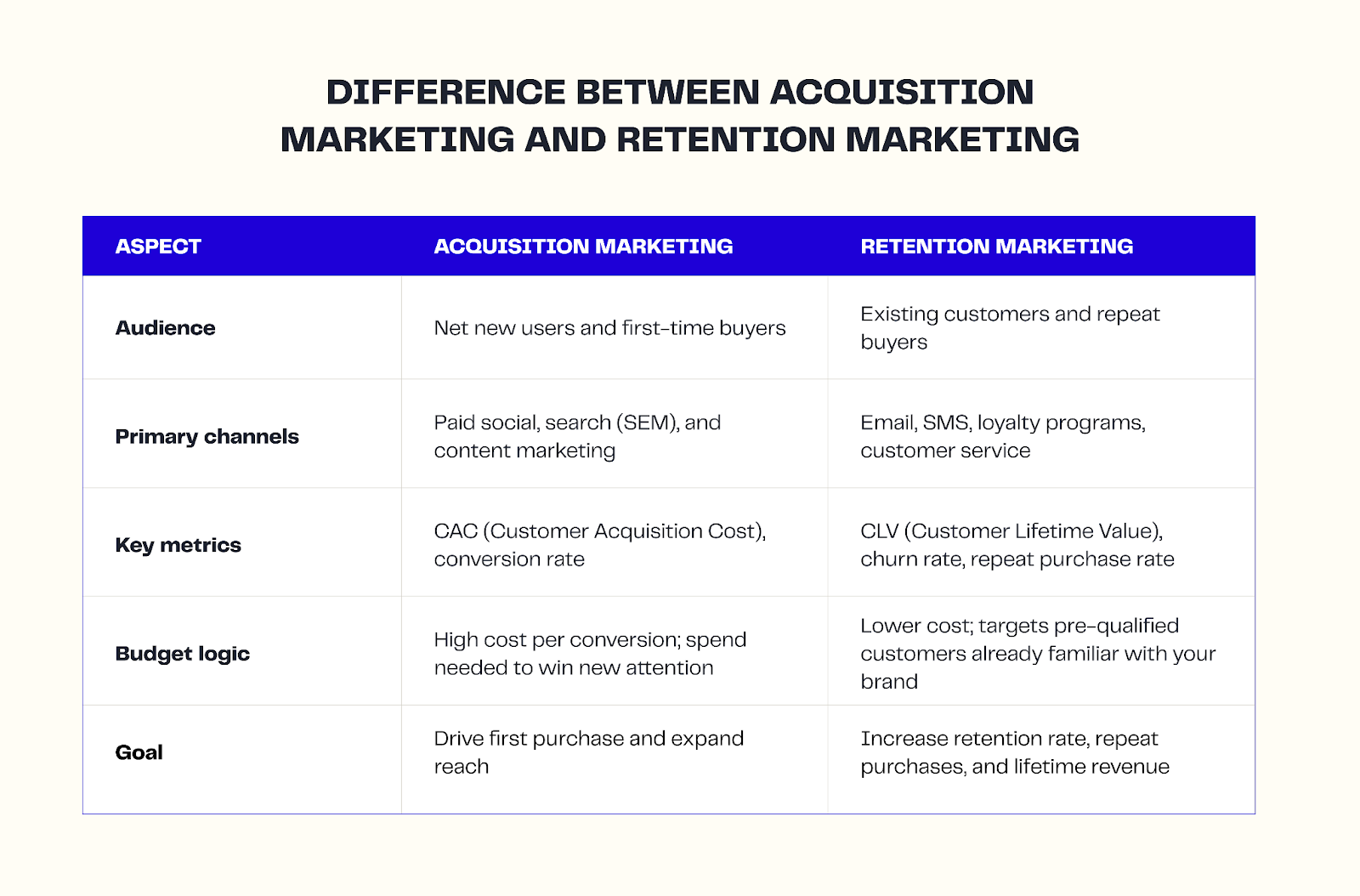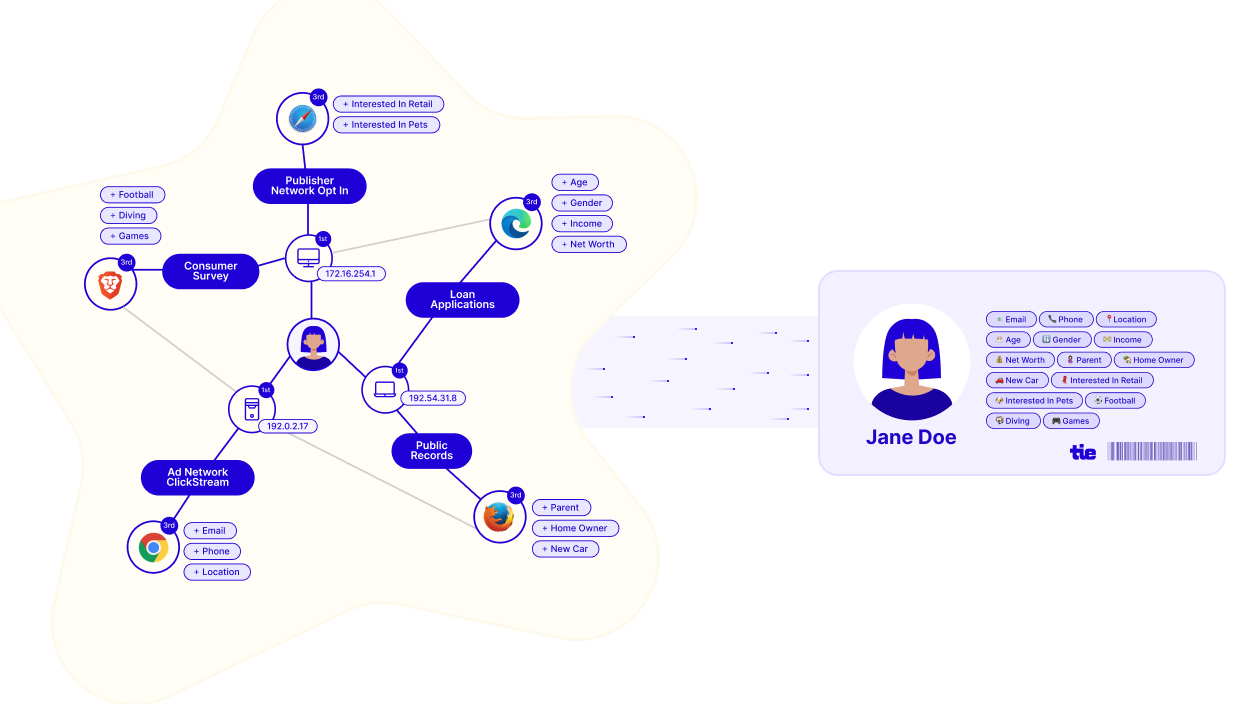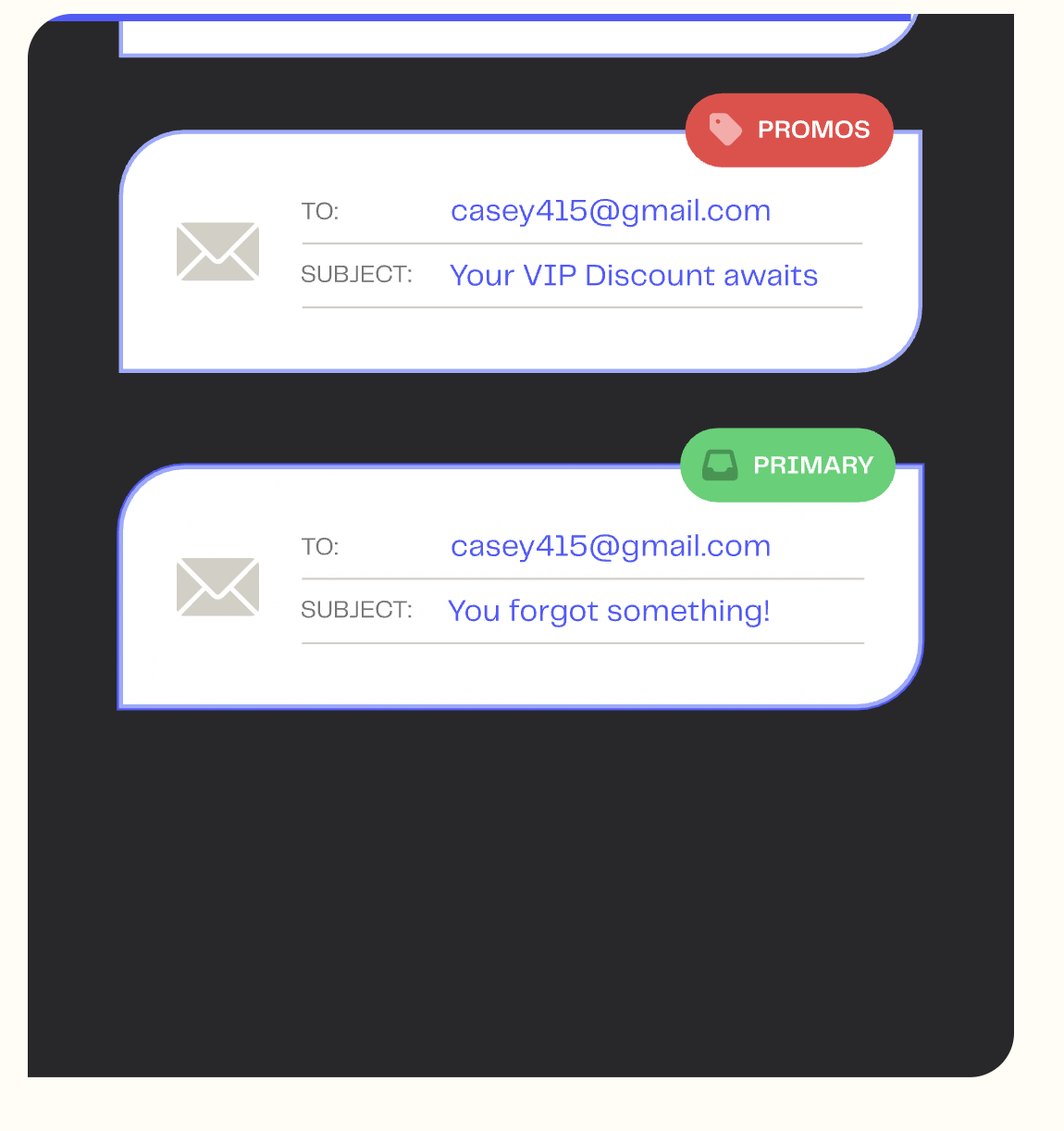What Is Retention Marketing?

If you’re not actively engaging your existing customers, you’re leaving easy revenue on the table. People forget fast. They browse, buy once, and move on unless the brand keeps them engaged through timely, relevant communication.
Retention marketing keeps your hard-earned customers active and buying again. It isn’t about pushing promo codes. It’s about showing up with the right message, at the right time, in the right channel.
When done well, it stabilizes revenue, lowers churn, and compounds the return on every acquisition dollar you’ve already spent. A returning customer costs less to influence and delivers far more lifetime value than a new one.
In this guide, we’ll break down what retention marketing really means, how it differs from an acquisition strategy, the key metrics and strategies that drive it, and how Tie helps brands turn customer relationships into repeat, measurable revenue.
What is customer retention marketing?
Customer retention marketing is the practice of keeping existing customers active, engaged, and buying again through structured, data-backed campaigns across channels like email, SMS, and push notifications.
You run these campaigns to maintain ongoing relationships and recover disengaged shoppers before they churn. The typical triggers include:
- Post-purchase onboarding: Help new buyers get the most out of their purchase, set expectations, and introduce your loyalty program.
- Browse and cart abandonment: Reconnect with shoppers who viewed or added products to their cart but didn’t check out.
- Win-back flows: Reach out to customers who haven’t purchased in a while with relevant offers or reminders.
- Loyalty and referral communications: Reward repeat customers with personalized offers, points, or early access.
Website visitor identification tools like Tie expand your reach by connecting anonymous site visitors to real, contactable profiles, even if they never filled out a form. This means your email and SMS flows can target a larger audience base, helping you:
- Bring more shoppers into post-purchase, win-back, upsell, or loyalty campaigns.
- Recover lost conversions from unrecognized traffic.
- Personalize communication across all customer touchpoints.
Retention marketing vs. acquisition marketing
Both acquisition and retention efforts aim to grow revenue, but they operate at different points in the customer journey. Acquisition focuses on attracting net new shoppers who don’t know your brand yet. Retention focuses on nurturing existing customers who’ve already engaged or purchased, making them more likely to buy again.
Here’s how they differ in strategy, cost, and impact:

Tie makes these two work together. By converting anonymous visitors into owned, consented audiences, you can get more value from your acquisition spend. Then, through verified email delivery and identity-matched campaigns, you can re-engage those shoppers directly, turning paid clicks into repeat customers who actually drive long-term ROI.
Why retention marketing matters
Retention marketing campaigns keep growth consistent after acquisition starts capturing new customers. It helps you make the most of your existing customer base: stabilizing revenue, improving margins, and lowering your dependence on paid ads.
Once customers are in your ecosystem, your focus shifts from chasing clicks to deepening engagement and driving repeat purchases.
Here’s why retention marketing strategies are critical for any scaling ecommerce brand:
- It keeps marketing costs predictable by targeting an audience that’s already qualified and familiar with your brand.
- It builds higher lifetime value (CLV) through consistent communication across email, SMS, and loyalty touchpoints.
- It turns short-term sales into compounding growth by converting one-time buyers into repeat customers.
For example, brands like CARIUMA used Tie to identify 37,829 previously anonymous visitors and drive 7,272 new purchases. The brand saw a 10% revenue lift tied directly to those identified users.

Similarly, OluKai improved email deliverability by using Tie, which moved emails in the Promotions tab to the primary inbox, driving 55% higher revenue per send and a 42% lift in click-through rates.
Data + identity: The foundation of retention
Strong retention relies on knowing exactly who your customers are, not just what they did last session. Identity resolution makes that possible by unifying every customer interaction across devices and channels into a single, accurate profile. This lets you deliver timely, relevant messages that reflect what shoppers are actually doing, not just what they did weeks ago.
When customer identities are updated in real time, your retention triggers (post-purchase, win-back, or loyalty flows) can respond instantly. That precision keeps your messages aligned with real behavior, improving customer experience, engagement, and reducing customer churn.
The most durable retention strategies are built on first- and zero-party data— information that customers willingly share through purchase histories, sign-ups, and on-site interactions. It’s compliant, privacy-safe, and future-proof as the world moves away from third-party cookies.
Tools like Tie’s customer identity resolution strengthen this foundation by:
- Recognizing returning shoppers across sessions, no cookies required, and matching them through IPs, devices, and email aliases.
- Enriching customer profiles with over 250 demographic and behavioral attributes for smarter segmentation and personalized experiences.
- Maintaining compliance by design, using verified consent, and avoiding any data co-ops or scraped sources.

Email deliverability’s role in retention
Email remains the backbone of most retention programs, but it only works if your messages actually land where customers see them. Inbox placement directly impacts engagement and revenue. When emails shift from the Promotions or Spam tab to the primary inbox, brands often see immediate lifts in click-through rate and revenue per send.
Deliverability directly determines how much revenue your retention program recovers. Strong authentication, clean lists, and consistent engagement signals tell inbox providers your messages deserve priority. Weak deliverability does the opposite — it erodes sender reputation and gradually pushes even good campaigns into low-visibility folders.
Tie’s Deliverability Suite fixes this at the infrastructure level:
- Warms your domains in a structured, metrics-based sequence to build reputation safely.
- Detects and blocks spam traps so invalid or risky contacts never hit your list.
- Simulates engagement with verified signals that strengthen sender authority over time.
The result is consistent inboxing. You keep your messages in front of real, active customers, improving both engagement and lifetime value with every send.

What is the retention rate in marketing?
Retention rate measures the percentage of customers who stay active or make repeat purchases within a given period, usually 30, 90, or 120 days. It shows how effectively you’re keeping existing customers engaged over time.
The formula is simple:

For example, if your 90-day retention rate is 70%, it means 7 out of 10 customers are still buying or engaging three months later. The remaining 30% represent churn, which equals 1 − retention rate.
Customer retention rate connects directly to other core KPIs:
- Repeat purchase rate: How many customers buy more than once.
- Customer lifetime value (CLV): The total revenue a customer generates over their relationship with your brand.
Together, these metrics help you evaluate how strong your customer relationships are and how much of your growth comes from brand loyalty rather than constant acquisition.
What is a retention strategy in marketing?
Customer retention strategies are the framework that keeps your existing customers engaged long after their first purchase. It’s built on clear, ongoing communication across the full customer lifecycle (from onboarding to re-engagement) to drive repeat sales and long-term loyalty.
Every brand’s channel mix looks different. Some lean on messaging and email marketing efforts, others on loyalty or customer service touchpoints. What matters is testing what keeps your users returning, and tracking how each effort impacts churn, repeat purchase rate, and customer lifetime value (CLV).
Retention marketing for ecommerce
In ecommerce, retention marketing is about turning first-time shoppers into long-term customers. It’s a structured system of automated campaigns that keeps users active through consistent, personalized communication, not one-off discounts or seasonal blasts.
The focus is on key behavioral triggers that move shoppers through the customer journey:
- Welcome flows that convert new sign-ups into first purchases.
- Browse abandonment messages that bring back high-intent visitors who didn’t add to cart.
- Cart abandonment reminders that recover lost checkouts before they churn.
The real value comes from connecting these moments. You start with anonymous traffic, use identification tools like Tie to match shoppers to real profiles, and then guide them into an ongoing CRM cadence across email and SMS.
Over time, that consistency compounds into higher repeat purchase rates, stronger customer lifetime value, and a steady flow of predictable revenue.
How Tie supports retention
Tie helps you turn more of your existing traffic into customers who stay. It connects identity, data, and deliverability, so your retention system reaches more people, with sharper precision and measurable impact.
Here’s how Tie supports retention:
- Grow email lists: Tie uncovers high-intent visitors who never filled a form and syncs them directly to your ESP. You get verified profiles enriched with demographic and on-site behavior data, letting you send messages that match real interests, and not assumptions.
- Customer identity resolution: Tie tracks returning shoppers across devices and aliases without relying on cookies. You can see who’s re-engaging, even if they switch browsers or log in differently, so your flows stay continuous and relevant.
- Customer data enrichment: Each identified user is enriched with 250+ verified data points, from location and purchase intent to lifetime value signals. You can segment by behavior and personalize follow-ups and offers with accuracy that generic ESP data can’t match.
- Protect email deliverability: Tie keeps your campaigns in the Primary inbox through structured domain warming, spam-trap filtering, and engagement simulations.
- Boost abandoned cart recovery: Tie identifies more abandoners than pixel- or cookie-based systems, giving you a larger, verified audience to retarget through email or SMS. The result is higher recovery volume and stronger flow-level ROI.
Turn disconnected customer data into clear, revenue-driving retention programs. Book your Tie demo today.
FAQs about retention marketing
Is retention marketing the same as lifecycle marketing?
No, retention marketing is not the same as lifecycle marketing.
Lifecycle marketing covers the full journey: acquire, retain, and turn customers into advocates. Retention marketing focuses on the post-acquisition stages: engagement, repeat purchases, and churn prevention.
What’s a good retention rate?
There’s no universal benchmark for a good retention rate. The right number depends on your category, product type, and buying frequency. Track 30-, 90-, and 120-day retention, along with churn, CLV, and repeat purchase rate, to measure progress against your own baselines.
Which channels work best for retention?
Email and SMS remain core channels for retention, supported by push notifications, social media retargeting, and on-site personalization.
The most effective mix varies by brand: test, measure, and double down on what drives revenue.
How does email deliverability impact retention?
Inbox placement can make or break your retention ROI. Moving from Promotions to Primary typically delivers 40–50% higher CTRs and double-digit revenue lifts per send. It’s one of the clearest drivers of campaign performance.
Do I need identity resolution for retention?
Yes, you need identity resolution for retention. Retention depends on recognizing the same customer across devices and sessions. Identity resolution unifies those touchpoints into a single profile, enabling accurate personalization and real-time retention triggers.
Retention marketing vs. acquisition: where should the budget go?
Both retention and acquisition are essential. Acquisition grows your base; retention makes that spend compound. Since retention targets a pre-qualified audience, it’s typically more cost-efficient and produces higher ROI per dollar.
What is selective retention in marketing? Is it the same as retention marketing?
Selective retention is not the same as retention marketing. It’s the more strategic, refined version of it. It is a strategy where brands choose which customers to actively retain based on profitability, fit, and long-term potential, instead of trying to keep every customer.
Traditional retention marketing focuses on keeping as many customers engaged and purchasing as possible through post-purchase flows, win-backs, loyalty programs, and lifecycle messaging.
What is retention in digital marketing?
In digital marketing, retention refers to keeping your loyal customers active and engaged through ongoing, consent-based communication.
The goal is the same as traditional retention: sustained customer engagement and higher revenue from your current customer base, but executed through digital channels like email, SMS, push notifications, and retargeting ads.
What is a marketing retention program?
A marketing retention program is a structured system of ongoing communications and incentives designed to keep existing customers active. It usually includes automated email, SMS, push, or customer loyalty campaigns that are personalized using first-party data.
Platforms like Tie strengthen these programs by linking verified identity, enrichment data, and deliverability, ensuring your messages reach the right people and actually land in the inbox.
What is a retention campaign in marketing?
A retention campaign is a specific message or sequence that targets current customers to drive a defined next action: a repeat purchase, reactivation, or renewal.
These are typically behavior-triggered: a cart abandonment flow, a “win-back” sequence, or a loyalty reminder. Each one extends the customer relationship instead of restarting it.
What is acquisition and retention marketing?
Acquisition and retention are two parts of the same growth engine. Acquisition marketing brings in new customers through paid and organic channels. Retention marketing keeps those customers buying, increasing CLV and reducing the need for constant ad spend.
Together, they form a sustainable system where acquisition fuels growth, and retention compounds it.








